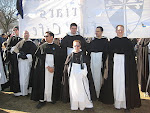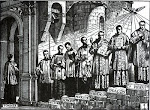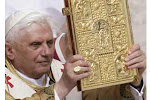These has been a recent problem with the PODCAST computer which is again in repair ! This is due back this week, so I might do further podcasts later this week. Hopefully this will be the last time this will have to be repaired for a while.
Apologies for this! But keep watching the blog.
LATER HISTORY OF THIS WELL, WHICH SURVIVED THE 'REFORMATION'.
will be posted appropriately after a return to Gwent.
PART WELL PLAYED DURING PENAL TIMES also will be posted appropriately.
Monday, March 30, 2009
Sunday, March 29, 2009
Saint Winifride's Holy Well -a 'Baptismal font for the World'










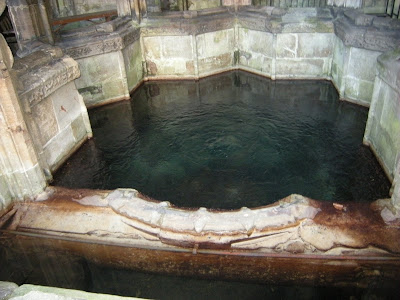



 __________________________________________________________________________________________________________________________________________________________________
__________________________________________________________________________________________________________________________________________________________________Heaven's fruitfulness before the cooling of the body
Is the virtue of Chastity.'
Following the trip to St Asaph, the following morning, after another comfortable stay at St Winifride's House and an excellent early breakfast, we went down to the shrine itself. There was a piety shop, very well stocked by two lay men who were able to furnish us with guidebooks and information and I bought some holyu medals for friends who had requested prayers. The museum was very interesting telling the story of the shrine from the beginning.The many crutches also stayed there, of people whose illnesses had been cured.
The guidebook begins with the following quote from Caxton's first printed version of the Life of St Winifride
....and after the hed of the vyrgynge was cut of and touchd the ground , as we have said, sprang up a welle of Spryngynge water largely endurying unto this day , which heleth all langours and sekenesses , as well in men as in bestes , which weele is named after the vyrgyne and is called St Wenefredes Well.....(1485)
I have explained the legend in a previous post. When men were still talking and writing Old English, they were building this fine perpendicular Gothic Chapel over the most famous healing well of the British Isles.It may have been the first chapel over the well, though for centuries there was one alongside in the place where the parish church continues to stand.It is here that St Beuno would have built the first wooden chapel in the 7th century. He no doubt used the well as a baptistery.
A stone church was, however what the Countess Adeliza of Chester gave to the Benedictine Monks of St Werbergh's Abbey, Chester in 1093 and it would have been this church, or a successor to it that was 'falling down' in the early fifteenth century. By the end of the 15th century the parish church was rebuilt , of which only the tower remains today -but the present well chapel was also constructed here. This chapel was the final testament to the cult of pilgrimage that had grown steadily through the Middle Ages. St Winifride's Well was already famous when in 1115 was written:
'Earl Richarde intended all thing to the best to visit Sainte Winifride , in herte desirous upon his journey went (myn authour sayth thus) devoutly to Holywell in pilgrimage for his great merite and gostly advantage'.
Attacked by ht e Welsh
When Earl Richard return four years later, he was attacked and fortunes of war affected the ownership and care of the well and church for more than a century.
Henry II rebuilt the castle at Basingwork 1157 but Owain Gwynedd and the Welsh destroyed it again.
Knights Templar
King Stephen during he time in Chester established the Knights Templar in Basinwerk to protect pilgrims, but Owain destroyed it again.
Monks from Savigny in France at Basingwerk
In 1131, these monks came to live in Basinwerk and became Cistercian in 1147.However at Basingwerk archeologists have found Saxon remains , showing a much earlier cell. Since St Beuno laboured to established Catholicism in a framework of monastic settlements , it is not impossible that this was the monastic cell he founded centuries earlier.(Check out Settlements of the Cetic Saints by Porfessor E.G.Bowen)
The link seems to be very old and Mass may have been continuous , except for the wars of England and wrangles with Chester Abbey . Ranulf , the third Earl of Chester built a castle on the hill above the well in 1209 because the monks of Chester had complained to Archbishop of Canterbury Hubert Walter (1193-1209) that:
'In the wars with the princes of Wales they have lost their Church at Hallewell which was £100 value'.
(Chartulary of the Abbey of St Werburgh)
The castle did not survive long. The monks of Basingwek were confirmed in their possession of the Well Church by Dafydd ap Llewellyn in 1240 and nothing remains of the castle except the name Bryn y Castell. It is an obvious defensive site.
Winifride(Gwenfrewi's) Parents house
This is believed to be the site of the parents of the saint and these were Tewth ap Eylud and Gwenlo. This was the childhood home of St Winifride.
On the right hand side were some changing cubilcles on the left a chapel, with a stained glass represent ation of St Winifride and St Beuno, and a large Statue of Our Lady and on the other wall a huge crucifix of Our Lord. Our Lady was almost covered in flowers.
I lit some candles and walked around the 15th century chapel, which had been the scene of numerous healings and the hopes of recusant Catholics.The tradition remained unbroken all the way up until today.
THE RITUAL INTERCESSION AND NOVENA PRAYERS AT THE SHRINE
You need to stop before the entrance to the shrine and make the sign of the Cross. Then you go to the front of the Well and make your intentions and recite the Apostles Creed. Then as you walk around the shrine three times , reciting the rosary, Our Father and Glory Be and today the Fatima Prayer.
If you yourself are the patient looking for healing, you are meant to do this in the pool, kneeling on the saint's stone in the well pool, or immersed in the deeper water up in the shrine itself. It has a high reputation for healing. Follwing a mining disaster in the 18th century the streams course was temporarily cut off, then found again, but the pool does not gush out as it used to in the old drawings.
Along all three walls are many votive stands bearing candles, and there is an ancient statue of the Sainton a large scale in the chapel surrounded by candles and with medals on her feet. The walls were blackend with the effects of candles over the centuries. The Museum is most interesting giving you the details and history. It was a cold February day, so my son poured the water from the well over my knees - it certainly freshened up my legs, but I know healing works in all sorts of ways. I loved the well and the Latin Mass that followed was the icing on the cake.
The Welsh poet Iolo Goch wrote a 'cywydd' poem
There ran from the earth
A God-given event-sweet are its graces-
A spring of water of which one drop excels all wealth
It's water, light , transluscent,
Is like that of the Jordan, under a fair elm tree,
It is a balm against every disease.
A gracious protection to the weak and the sick;
It redeems the weariness of thousands.
A Blessed Fountain of the Faith,
A clear-shining river from the hillside,
Its water is seen from the meadows
As a wave above its gravelly bed.
Then there is a vivid description of the gushing spring water as its leaps from its source, a description which suffers tin translation.
Ieuan Bryddydd Hir, also wrote a poem about all the miracles wrought by te Saint and the well. 'Generous as the Midsummer sun on the Baptist's Feast'.
He wrote
Here is the Fountain of the Faith
A baptismal font for the World.
Tudor Aled wrote:
It is a breath of heaven in the Vale
And the breeze which comes from it
Is as the honey bees first swarming
A sweet odour over the turf
Of musk or balm in the midst if the world.
The drops of her blood are like the red shower
Of the berries of the wild rose
The Tears of Christ from the height of the Cross.
The power of the Saint's prayers spring, says Tudor, from the prayers of the Mass, offered as it was at the site of her martyrdom. Tudor explicitly relates the wonders of Holywell to the great treasury od Christ's merits. His devotion is founded on Theology.
William Byrinsa (early 17th cent) wrote
A well in a much loved dwelling
I know, that on high, it belongs to Gwenfrewi. (Winefride)
Other poets wrote about the healing of bodily wells because of the prayers and intercessions of St Winefride.
To have a lively and privileged life force
A worthy tenderness made warmer by Jesus
Gwenfrewi's fine well
Cleanses the soul.
The Glory of Hospitality, Family and Marriage
These excerpts of poetry are by T Charles-Edwards and his Historical background. I will finish with his words.
'The Welsh poets saw Wales as a great society composed of families; to use the metaphor of which they were so fond, as a growve of wide-branching trees, sturdy, shapely and fruitful. They saw this society as bound together by friendship and hospitality and reaching right up to the Court of Heaven , and to the very foot stool of God and in the persons of the native saints of the kindred and the countryside. It was suitable that Tudor Aled whose glory it was to see all this so clearly, should grace the cultus of St Winefride with one of the great poems of Welsh literature: for hearth and home, friendship, kindred and hospitality have for their guardian the hard and steadfast virtue of Chastity'.
Heaven's fruitfulness before the cooling of the body
Is the virtue of Chastity.'
So this makes Winefride a modern saint too as Charles Edwards writes
'It was the peculiar glory of this Welsh girl of the seventh century to defend and glorify the tradition of Chastity and the family, this tradition, in its Catholic and Christian setting, against that contemptuous list lust which is the hall mark of a barbarian, bringing to it gifts of spiritual and physical healing. ONce that is clear, it is also clear, why the cultus of Saint Winifride had outlasted the changes and chances of thriteen centuries'.
We visited one more holy place before we left North Wales, but I will write about that again as it is a slightly younger place than the holy well of the saint.Curiously I have to confess I was given this name at birth (Winifride) and really hated it. I felt it was really old fashioned and every time it wasmentioned in school , I squirmed. Yet when I was received into the Catholic Church,by Father Fitz (John Fitgerald) it was at the little Catholic Church of Our Lady and St Winifride in Aberystwyth, and at every Welsh pilgrimage , she is prayed to for intercession and the Conversion of Wales.
Friday, March 20, 2009
St Asaph and St Kentigern-
Old Welsh Prayer to the Lord of Heaven
Lord of Heaven, grant me my prayer to you
Make my praise of you free me from punishment
God asks me well:
'Did you see the Lord's grave prophecy?'
He released the spoils of Hell
And gathered the imprisoned host to himself
Before I am powerless...
Let me be steadfast for the Lord of strength
Before I suffer a bloody death
Before my mouth slavers
Before I am joined to wooden boards.
May my soul be filled with his good food
The script of books tells me little.
Of hard affliction after the deathbed.
May those who have heard my song
Come to heaven, highest dwelling.
I love this poem, of the period but yet anonymous. The poem is of the bardic type and praises the Eucharist above the scriptures - Jesus of the Eucharist accompanies him in battle and signs him in the next world and his affliction in Purgatory.











Whilst we made our pilgrimage to St Winifride at Holywell and Gwytherin below (hope you are following the radio programme on iTunes as well-also called Mary in Monmouth.This gives greater detail about the church at Gwytherin.
http://www.maryinmonmouthshire.libsyn.com/rss
Follwing the visit to Gwytherin we had lunch and then travelled past Rhuddlan Castle (unfortunately closed for the winter ) and made our way down to St Asaph which was one of the oldest foundations in Wales, founded by St Kentigern. It is a feature of Celtic devotion as to the devotion afforded to the Celtic holy men-Kentigern was also called MUNGO which means 'Dear one')His monastic foundation was called 'Clas-gu'(the 'Dear Family') =Glasgow.
St Kentigern was a Bishop, born in Culross in Fife. about 518; He also died there on 13 January, 603. His mother Thenaw was the daughter of a British prince, Lothus (from whom the province of Lothian was called); We don’t know the name of his father. At the age of twenty-five we find Kentigern (the name means "head chief", but he was popularly known as Mungo — in Cymric, Mwyn-gu, or "dear one"), beginning his missionary labours at Cathures, on the Clyde, the site of modern Glasgow.
The Christian King of Strathclyde, Roderick Hael, welcomed the saint, and procured his consecration as bishop, which took place about 540. For some thirteen years he laboured in the district, living a most austere life in a cell at the confluence of the Clyde and the Molendinar, and making many converts by his holy example and his preaching. A large community grew up around him, became known as "Clasgu" (meaning the "dear family") and ultimately grew into the town and city of Glasgow.
Anti-Christians in Strathclyde
About 553 a strong anti-Christian movement in Strathclyde compelled Kentigern to leave the district, and he retired to Wales, staying for a time with St. David at Menevia, and afterwards founding a large monastery at Llanelwy, now St. Asaph's, of which he appointed the holy monk Asaph superior in succession to himself.
After he left the Monastery-now St Asaph’s
In 573 the battle of Arthuret secured the triumph of the Christian cause in Cumbria, and Kentigern, at the earnest appeal of King Roderick, returned thither, accompanied by many of his Welsh disciples. For eight years he fixed his see at Hoddam in Dumfriesshire, evangelizing thence the districts of Galloway and Cumberland. About 581 he finally returned to Glasgow, and here, a year or two later, he was visited by St. Columba, who was at that time labouring in Strathtay. The two saints embraced, talked for a great deal of time, and exchanged their pastoral staves.
Kentigern was buried in Glasgow
Kentigern was buried on the spot where now stands the beautiful cathedral dedicated in his honour. His remains are said still to rest in the crypt. His festival is kept throughout Scotland on 13 January. The Bollandists have printed a special mass for this feast, dating from the thirteenth century.
St Asaph
Later some historians postulate that the Roman fort of Varae sat on the site of the Cathedral. However, the town is believed to have developed around a sixth century Celtic monastery founded by Saint Kentigern, and is now home to the small fourteenth century St Asaph Cathedral. This is dedicated to Saint Asaph (also spelt in Welsh as Asaff), its second bishop.
The Fourteenth Century
The great age of rebuilding took place between 1284 and 1392. The exterior of the Cathedral reveals the different kind of stone used.. Anian II was succeeded as bishop by Llywelyn of Bromfield (1293-1315). His first work was to reform the administration of the Cathedral, make provisions for the Cathedral services and to ensure that the sources of revenue for the Cathedral were sufficient to maintain the building. Rectorial tithes were given as well as "Terra Faborum" (fabric lands). Once this was done Bishop Llywelyn set in motion the rebuilding of the Cathedral. Dr. John Madison suggests that a unified scheme was undertaken sometime between 1310-20:
The transepts, which were the last works to be rebuilt, were probably added between 1315 and 1320.
This rebuilding programme was influenced by the military works being undertaken at Caernarfon Castle. The person probably responsible for the rebuilding work at the Cathedral was Master Henry of Ellerton (d.1323) who succeeded Master Walter of Hereford (d.1309) at Caernarfon.
Money to finance rebuilding and maintenance was raised in a variety of ways. Pilgrims were encouraged by indulgence to visit the Cathedral and give alms to the fabric. The chief object of their devotion must have been the Shrine of St Asaph (mentioned by Edward I in his letter to Pope Martin IV), and the Reliquary in which was preserved the famous copy of the Gospel of the Evengalthen.
The Fifteenth Century
In 1402 the Cathedral was visited by Owain Glyndwr and his rebels who wrought havoc. Browne Willis described the day
The Chirch Cathedral of Saint Asaph, with the steple, bells, quere, porch, and vestiary, with all other contentis, chaliz, vestiments, and other ornaments, as the bokes, stalls, deskes, altres, and all the aparaill longging to the same chirch, was brent and utterly destroyed, and in likewys the byshop's palays and all his other three mannoirs no styke left.
The bishop, John Trefor II, allied himself with Glyndwr and was removed to be succeeded by Robert de Lancaster, Abbot of Valle Crucis and bishop (1411-33), who re-roofed the nave and carried out other repairs. The damage done to the Cathedral by Owain Glyndwr's troops is probably exaggerated. The transepts remained roofless until the work of restoration was completed by Bishop Richard Redman (1471-95)
Life went on as normal until Queen Elizabeth took the church for the Anglican Communion who presently administer the Cathedral. The relics were destroyed but St Asaph houses the first Bible translated into Welsh by Jones, which Welsh Speakers say saved the Welsh language. They are housed in a separate chapel in the North Transept ,very modern in furnishings and quite plain.
My Visit
The church is a little gem, small for a cathedral, well appointed and the furnishings sparse. There is one tiny statue of the Blessed Virgin in ivory encased in glass in a pillar. There is no pulpitum. The effigy and tomb of Bishop Anian is there and striking is a very abstract sculpture of Chris resembling a cadaver on the cross (see the above picture) There are some beautifully carved choir stalls and stained glass.Coffee was thoughtfully left on a table at the back! The Lady Chapel contained the Christ sculpture and the other chapel on the North transept the collection of ancient Bibles. A pretty cathedral.
St Asaph’s Original Church
This still exists at the bottom of the hill where the Celts usually built their foundations. Unfortunately the Church in Wales have closed the church. This is tragic as it was the original foundation on the site. Even as a historical monument it should be preserved, but would be wonderful as a shrine to the Blessed Mungo and his pupil Asaph, but the Church in Wales has to maintain large numbers of churches with dwindling congregations and it is difficult.
My overall impression was of the Cathedral, a beautiful surrounding but nevertheless I guess quite sparsely furnished.Nevertheless definitely worth a visit if you visit North Wales.C
Lord of Heaven, grant me my prayer to you
Make my praise of you free me from punishment
God asks me well:
'Did you see the Lord's grave prophecy?'
He released the spoils of Hell
And gathered the imprisoned host to himself
Before I am powerless...
Let me be steadfast for the Lord of strength
Before I suffer a bloody death
Before my mouth slavers
Before I am joined to wooden boards.
May my soul be filled with his good food
The script of books tells me little.
Of hard affliction after the deathbed.
May those who have heard my song
Come to heaven, highest dwelling.
I love this poem, of the period but yet anonymous. The poem is of the bardic type and praises the Eucharist above the scriptures - Jesus of the Eucharist accompanies him in battle and signs him in the next world and his affliction in Purgatory.











Whilst we made our pilgrimage to St Winifride at Holywell and Gwytherin below (hope you are following the radio programme on iTunes as well-also called Mary in Monmouth.This gives greater detail about the church at Gwytherin.
http://www.maryinmonmouthshire.libsyn.com/rss
Follwing the visit to Gwytherin we had lunch and then travelled past Rhuddlan Castle (unfortunately closed for the winter ) and made our way down to St Asaph which was one of the oldest foundations in Wales, founded by St Kentigern. It is a feature of Celtic devotion as to the devotion afforded to the Celtic holy men-Kentigern was also called MUNGO which means 'Dear one')His monastic foundation was called 'Clas-gu'(the 'Dear Family') =Glasgow.
St Kentigern was a Bishop, born in Culross in Fife. about 518; He also died there on 13 January, 603. His mother Thenaw was the daughter of a British prince, Lothus (from whom the province of Lothian was called); We don’t know the name of his father. At the age of twenty-five we find Kentigern (the name means "head chief", but he was popularly known as Mungo — in Cymric, Mwyn-gu, or "dear one"), beginning his missionary labours at Cathures, on the Clyde, the site of modern Glasgow.
The Christian King of Strathclyde, Roderick Hael, welcomed the saint, and procured his consecration as bishop, which took place about 540. For some thirteen years he laboured in the district, living a most austere life in a cell at the confluence of the Clyde and the Molendinar, and making many converts by his holy example and his preaching. A large community grew up around him, became known as "Clasgu" (meaning the "dear family") and ultimately grew into the town and city of Glasgow.
Anti-Christians in Strathclyde
About 553 a strong anti-Christian movement in Strathclyde compelled Kentigern to leave the district, and he retired to Wales, staying for a time with St. David at Menevia, and afterwards founding a large monastery at Llanelwy, now St. Asaph's, of which he appointed the holy monk Asaph superior in succession to himself.
After he left the Monastery-now St Asaph’s
In 573 the battle of Arthuret secured the triumph of the Christian cause in Cumbria, and Kentigern, at the earnest appeal of King Roderick, returned thither, accompanied by many of his Welsh disciples. For eight years he fixed his see at Hoddam in Dumfriesshire, evangelizing thence the districts of Galloway and Cumberland. About 581 he finally returned to Glasgow, and here, a year or two later, he was visited by St. Columba, who was at that time labouring in Strathtay. The two saints embraced, talked for a great deal of time, and exchanged their pastoral staves.
Kentigern was buried in Glasgow
Kentigern was buried on the spot where now stands the beautiful cathedral dedicated in his honour. His remains are said still to rest in the crypt. His festival is kept throughout Scotland on 13 January. The Bollandists have printed a special mass for this feast, dating from the thirteenth century.
St Asaph
Later some historians postulate that the Roman fort of Varae sat on the site of the Cathedral. However, the town is believed to have developed around a sixth century Celtic monastery founded by Saint Kentigern, and is now home to the small fourteenth century St Asaph Cathedral. This is dedicated to Saint Asaph (also spelt in Welsh as Asaff), its second bishop.
The Fourteenth Century
The great age of rebuilding took place between 1284 and 1392. The exterior of the Cathedral reveals the different kind of stone used.. Anian II was succeeded as bishop by Llywelyn of Bromfield (1293-1315). His first work was to reform the administration of the Cathedral, make provisions for the Cathedral services and to ensure that the sources of revenue for the Cathedral were sufficient to maintain the building. Rectorial tithes were given as well as "Terra Faborum" (fabric lands). Once this was done Bishop Llywelyn set in motion the rebuilding of the Cathedral. Dr. John Madison suggests that a unified scheme was undertaken sometime between 1310-20:
The transepts, which were the last works to be rebuilt, were probably added between 1315 and 1320.
This rebuilding programme was influenced by the military works being undertaken at Caernarfon Castle. The person probably responsible for the rebuilding work at the Cathedral was Master Henry of Ellerton (d.1323) who succeeded Master Walter of Hereford (d.1309) at Caernarfon.
Money to finance rebuilding and maintenance was raised in a variety of ways. Pilgrims were encouraged by indulgence to visit the Cathedral and give alms to the fabric. The chief object of their devotion must have been the Shrine of St Asaph (mentioned by Edward I in his letter to Pope Martin IV), and the Reliquary in which was preserved the famous copy of the Gospel of the Evengalthen.
The Fifteenth Century
In 1402 the Cathedral was visited by Owain Glyndwr and his rebels who wrought havoc. Browne Willis described the day
The Chirch Cathedral of Saint Asaph, with the steple, bells, quere, porch, and vestiary, with all other contentis, chaliz, vestiments, and other ornaments, as the bokes, stalls, deskes, altres, and all the aparaill longging to the same chirch, was brent and utterly destroyed, and in likewys the byshop's palays and all his other three mannoirs no styke left.
The bishop, John Trefor II, allied himself with Glyndwr and was removed to be succeeded by Robert de Lancaster, Abbot of Valle Crucis and bishop (1411-33), who re-roofed the nave and carried out other repairs. The damage done to the Cathedral by Owain Glyndwr's troops is probably exaggerated. The transepts remained roofless until the work of restoration was completed by Bishop Richard Redman (1471-95)
Life went on as normal until Queen Elizabeth took the church for the Anglican Communion who presently administer the Cathedral. The relics were destroyed but St Asaph houses the first Bible translated into Welsh by Jones, which Welsh Speakers say saved the Welsh language. They are housed in a separate chapel in the North Transept ,very modern in furnishings and quite plain.
My Visit
The church is a little gem, small for a cathedral, well appointed and the furnishings sparse. There is one tiny statue of the Blessed Virgin in ivory encased in glass in a pillar. There is no pulpitum. The effigy and tomb of Bishop Anian is there and striking is a very abstract sculpture of Chris resembling a cadaver on the cross (see the above picture) There are some beautifully carved choir stalls and stained glass.Coffee was thoughtfully left on a table at the back! The Lady Chapel contained the Christ sculpture and the other chapel on the North transept the collection of ancient Bibles. A pretty cathedral.
St Asaph’s Original Church
This still exists at the bottom of the hill where the Celts usually built their foundations. Unfortunately the Church in Wales have closed the church. This is tragic as it was the original foundation on the site. Even as a historical monument it should be preserved, but would be wonderful as a shrine to the Blessed Mungo and his pupil Asaph, but the Church in Wales has to maintain large numbers of churches with dwindling congregations and it is difficult.
My overall impression was of the Cathedral, a beautiful surrounding but nevertheless I guess quite sparsely furnished.Nevertheless definitely worth a visit if you visit North Wales.C
Labels:
Kentigern,
Mungo,
St Asaph,
St Asaph Cathedral
Thursday, March 12, 2009
St Winifride, Blessed Saint of Wales-7th century-Part 1 Ave Maria House and Gwytherin




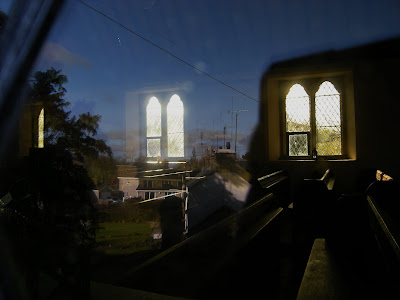

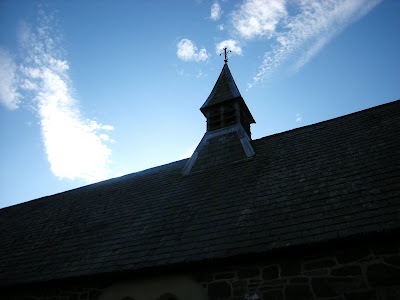





Apologies for all for the long delays in the blog, due mainly to both my computers crashing within days of each other. Hopefully normal service is now resumed.
Holywell
Two weeks ago on my weekend off, my family and I made a pilgrimage to where so many pilgrims from Monmouthshire went in the Middle Ages, to the Shrine of the Blessed St Winifred. This shrine at Holywell (The Holy Well of St Winifride) is the only shrine from Britain to come unscathed through the Reformation as the most recent building to the shrine was built by Lady Margaret, grandmother of Henry VIII.
The shrine's location is easy -off the M5-M6 at Chester and along the motorway to Chester and only a stone' s throw from Liverpool with its port and airport.
St Beuno, the local Bishop and monastic leader is said to have been the uncle of the saint.
Winifride's story-Gwenfrewi Sant in Welsh
Winifride was the daughter of two local families of standing in the Holywell area.They were as you would expect of a royal family Tewych and his wife Gwenlo. Gwenfrewi had decided to live a consecrated life as a nun but remained within her father's house until she came of age. When her parents were out of the house, a neighbouring chieftain, Caradoc came to visit, and she welcomed him as the laws of hospitality decreed. But Caradoc was overome with lust, tried to rape Gwenfrewi who managed to get away from him and ran out of the house. He set off after her and struck at her head with his sword. Where she fell, a spring of water flowed up . St Beuno came out from the church and placed her head back on her body. He led the others in prayer and she was raised to life again. A white scar was seen around her neck in witness to her martyrdom . Caradoc received the biblical punishment as the earth swallowed him up and he was never seen again.
When she was completely recovered, St Beuno made Winifred an abbess-leader of the new settlement at Gwytherin. He had discovered there a very ancient site and wished her and the holy brethren to serve God there.She died and was buried there.
Benedictines from Shrewsbury Abbey
In 1138 , Shrewsbury Abbey,a Benedicine abbey decided to come to Gwytherin and remove the bones (relics)to their own house. Most of her bones were destroyed by Protestant zealots during the time of Henry VIII and Elizabeth I but a pious person saved one finger for his own relic.This was later given back. Shrewsbury Cathedral had part of it, and the Catholic Chapel at Holywell was given the other.Both places have shrines on St Winifride's trail.
Holywell is greatly loved in Wales. It was not destroyed so many precious artifacts were hdden there, to prevent theft by various Protestant factions as abbeys and monasteries were demolished elsewhere in Britain.In particular it was a stronghold of the Jesuits supporting the recusant (secret) Catholics in penal times and many covert priests found sustenance and support there as multitudes flocked there all the way through penal times.
Celtic Holywell
In the 7th century St Beuno built the first little mud and wattle or wooden church next to the well, which would have been used for baptisms in accordance with the custom of Celtic Catholics (Universal Christians) After the Canquest, the Norman lady gave the church to St Werburgh's Abbey in Chester (1093)but by then it was probably a finer church of stone, built with alms from the many pilgrims.In the fifteenth century it was said to be falling down , and so was rebuilt by Lady Margeret of Richmond , Henry VIII grandmother.The present well chapel (now buing refurbished) was a final testament to piety and taste for pilgrimage in the Middle Ages.1115 Bradshaw wrote:
Erle Richarde intended all the dying to the best to visit Saynte Winifride , in heart desirous upon his journey went (myn autour sayeth thus) devoutly to Holywell in pilgrimage for his great merite and gostly (spiritual) advantage'.(Quoted from the Guide book by Christopher David.
The Well had a long association with Basinwek Abbey. There was a castle there originally and a House of Poor Knights Templar, whose duty it was to protect pilgrims coming to the Well. 1131AD monks from Sevigny in France had founded a Cistercian monastery at Basingwerk which remained, being on good terms with the Welsh under Owain Gwynedd. On excavating the abbey remains (also destroyed under the auspices of Henry VIII) a Saxon cell was discovered and this indicates a much earlier religious settlement from the 7th century, and some feel this may have been another foundation by St Beuno. Indeed a castle was built on the hill over Holywell in 1209 to protect the Well because the monks of Chester Abbey (now Chester Cathedral-Anglican) complained that the church at Holywell had been lost and had cost £100.The Welsh King Dafydd ap Llewelly gave the Well back to Basingwerk -closer and more Welsh friendly than the English Benedictines at Chester and nothing remains now-except the name 'Bryn y Castell'. More of the history anon.
Arrival at Holywell
We arrived on that February night, with satnav, but unfortunately many roads were being repaired and all arterial roads leading to them and so were reliant to signs saying ' Don't use satnav use this diversion!so having got lost a few times we made it to Holywell when it was very dark, but found the Convent at Ave Maria House and the Pilgrimage Centre close to the Well. We were greeted by two of the Bridgettine Nuns the portress and a 'greeter' who took us to out rooms. At £35 for B and B we thought the standard of the house was excellent. It has recently been refurbished and the rooms bright and neutral with beautiful modern shower rooms all finished to an excellent standard. The bes were comfortable and a Bible and 'History of St Bridget' in every room.
We spent a warm and comfortable night.A lift is even provided for someone like me with a damaged knee!
The Refectory was beautifully appointed, with flowers on the table and white tablecloths and we were treated to English breakfast and toast and cereal by very cheerful nuns. My husband said it did not feel right to have nuns waiting on your table, but hospitality is a charism of the Benedictines and actually in Wales as well. I can remember members of my mother's generation 'waiting' on visitors-even family, before eating themselves! Sadly it was this hospitality which led to Winifride's demise.
Gwytherin
Our first port of call was the village of Gwytherin, as it was furthest away from Holywell. We drove through wonderful hills, valleys and old Celtic earthworks to arrive here, our ears popping opposite the Lion Inn, the house opposite the Church.Now the jouney had taken but one hour and 5 mins from Holywell.(LL22822 satnav) A55,A547,A548.A544, B5382,B5384)
The Church
As we arrived, there was brilliant sunshine and a walker was doing up his shoes on the bench outside the Lion. He was walking over the top today he said, having just breakfasted he wanted to sit in the sun while he waited for his friends.This is a Welsh speaking area but there are many tourists here.
Archdeacon Thomas reported there was a ''Clas' foundation here in Celtic times and this would tie in with what we know about the Royal nature of Winifride's/Gwenfrewi's
family. Only Royal families could endow clas foundations.However the earliest dedicatee was St Eleri, an even earlier Welsh saint but when the Normans rebuilt the church on the same site, they dedicated it to St James.IT was some time before they came to grips with the Welsh culture,finding the language impossible. There is a knoll to the south of the Church which was dedicated to St Winifride (called the Penbryn Chapel) and recent research suggested the earliest 'llan' here included this chapel. I guess it might have been the original 'Capel y bedd' or grave chapel of the Virgin. This is still to be observed in North Wales, how many graves in Christian Churchyards resemble cromlechs, though dedicated to God and carrying the bones of the departed saint.
It appeared in the Pope's Taxatio in 1254 (Ecclesia de Gwytherin et Nanclyn)The Chapel had its own enclosure for a while (probably as the site had become a place of pilgrimage) There is a report from 1852 (Glynne) that the church was a simple one 'with a roof of the usual Welsh Construction'. There was some stained glass and a later report of 1858 says there were two wooden chests, of one which was a portion of the coffin of St Winifride, an octagonal font. There are also four ancient yews in the churchyard (still there today) . There is a round headed priest's door which had been blocked and a dormer window to light the gallery. By the 1860's it was run down and rebuilt according to its original specifications in 1867-9.Two mediaeval grave stones were uncovered at this time.
In 1990 the church was rededicated after de-consecration in 1982 and 8 years of disuse.Archesologists came with geophysics to find the chapel site in the field to the South of the Church. This is certainly where legend has it. In the recent ITV Cadfael series in the episode 'A Morbid Taste for Bones'it is certainly the location and the uncovering of the grave site is reenacted. This episode is now on DVD. The geophysics team could not find it.In 1729 the site was incorporated withing the Gwytherin Churchyard again, and it is possible that being a 'Chapel' area, Protestants had removed every trace of the 'Capel y Bedd'during the time of the dictator Cromwell.The ground drops to a natural hollow before rising to the site of the Penbryn Chapel.
Now there is a neat church, with excellently kept graveyard. It has a neve and chancel in one chamber a south porch and a north vestry. There is a small bell turret centrally set over the nave in line with the porch and it faces East as you would expect-towards Jerusalem.
The Church Interior
We were not allowed inside the church for reasons I shall explain in a minute.But from a description, the walls are whitewashed . The floor of the nave is tiled. Interestingly there are two steps up to the sanctuary (no Chancel) which has a grave slab and another in the north wall, possibly the original site of the Easter Sepulchre.(Place where the Crucifix and veils etc for Maundy Thursday, Good Friday and Easter Vigil were kept)These were also desecrated and destroyed by Elizabeth's officers.
Churchyard Items
In keeping with the site of the Church and Chapel being on an earlier site-possibly Druid place of meeting or 'initiation', there are four aligned stones, standing next to each other. One you can still read as a Latin incription 'Vinnemaglus , son of Senemaglus over an even older Ogham (celtic tree alphabet incription).(These are dated to the 5th or early 6th centuries)These are less than three metres apart.
There are four ancient yew trees.
Gwytherin lies in a valley that serves as the confluence of the River Afon Cledwen with the many streams that flow down from the hillsides.
Gwytherin Church-The Plight of the Gwytherin Christians in 2009
In the churchyard I met Sue who still acts as a church warden to the church. She told me, although the church had a loyal congregation of 8 (regular worshippers) more at Christmas and Easter that the Church in Wales had closed it down to be sold! I was very surprised as it had only just been rededicated and repaired with I guess lottery money. She told me that the Welsh Chapel on the hill had closed down through lack of members and the church had actually been sold to two local men who wanted to open it up again for worship for the community once a month. She said all eight had stopped going to Church and the brothers had been refused planning permission by Conway Council (??) I think they were hoping it would be sold to a private buyer, but no explanation was given. I think this is ridiculous. The village is overrun with tourists in the summer and pilgrims, doing the Winifred Trail.Moreover the locals are convinced that some of the remains of St Winifred remained there.I also was sorry I could not go in-as I do to say the rosary in all these pilgrimage sites, and had to content myself with sitting on a cromlech (I know-but no bench) and saying the Glorious mysteries for a women who reputedly spent 30 years of her life in this place in the service of God.You can hear my conversation with Sue on the podcast I am releasing in the next few days.
Let us hope that the intercession of Gwenfrewi/Winifride for the people of her settlement will have a good outcome, as they have appealed the decision by the council. Everyone should visit this special village.
My next post will concern where we went that afternoon-the Cathedral Church of St Asaph (now Anglican)founded by St Kentigern in AD 560!
Subscribe to:
Posts (Atom)




